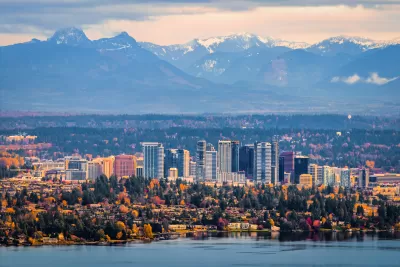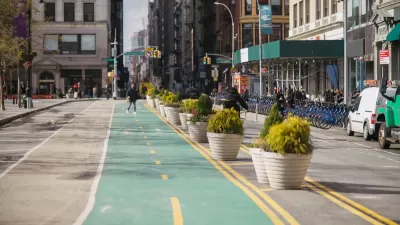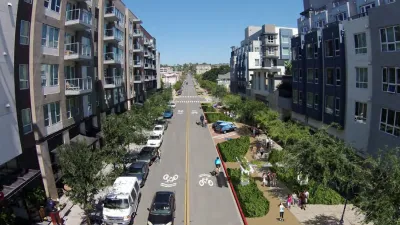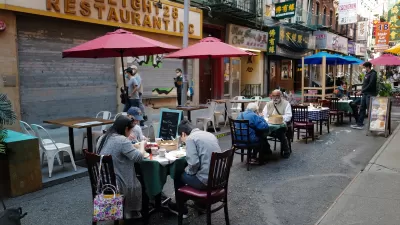The plan reorients the city’s priorities from vehicle throughput and parking to transit, bike infrastructure, and other public amenities.

The city of Bellevue, Washington wants to create a consistent set of rules governing curbside space, reports Ryan Packer in The Urbanist, with a focus on shifting away from single-occupancy vehicle movement and storage through a new Curb Management Plan. “In the works since early 2022, the plan has been molded and shaped over many months of outreach and years of work to provide city leaders a toolkit for how to move forward with rethinking how those valuable spaces function to achieve broader city goals, like improved safety, vibrancy, and increased transit ridership.”
Packer explains that, currently, just 3 percent of Bellevue’s curb space is dedicated to loading zones, bus stops, or transit lanes. 60 percent of curb space is used for vehicle throughput, Packer adds. “Having fast-moving traffic directly next to pedestrian traffic also provides no buffer, impacting the city’s safety goals.”
The plan puts in motion a series of pilot programs, including one that would promote parking in off-street stalls and another that would study the potential for on-street loading. “All of these will be happening against the backdrop of the continued expansion of the city’s bike network along growth corridors near coming light rail stations, a plan being called Bike Bellevue.”
The article quotes Christopher Randels, chair of Complete Streets Bellevue, saying, “I hope that this framework, by creating more spaces that are not devoted to automobile traffic… starts to change the culture of the city in a way that pedestrians, cyclists are more visible, they’re more seen as a part of the transportation ecosystem.”
FULL STORY: Bellevue Rethinks How It Uses Its Most Valuable Real Estate: Curbspace

Study: Maui’s Plan to Convert Vacation Rentals to Long-Term Housing Could Cause Nearly $1 Billion Economic Loss
The plan would reduce visitor accommodation by 25,% resulting in 1,900 jobs lost.

North Texas Transit Leaders Tout Benefits of TOD for Growing Region
At a summit focused on transit-oriented development, policymakers discussed how North Texas’ expanded light rail system can serve as a tool for economic growth.

Why Should We Subsidize Public Transportation?
Many public transit agencies face financial stress due to rising costs, declining fare revenue, and declining subsidies. Transit advocates must provide a strong business case for increasing public transit funding.

How to Make US Trains Faster
Changes to boarding platforms and a switch to electric trains could improve U.S. passenger rail service without the added cost of high-speed rail.

Columbia’s Revitalized ‘Loop’ Is a Hub for Local Entrepreneurs
A focus on small businesses is helping a commercial corridor in Columbia, Missouri thrive.

Invasive Insect Threatens Minnesota’s Ash Forests
The Emerald Ash Borer is a rapidly spreading invasive pest threatening Minnesota’s ash trees, and homeowners are encouraged to plant diverse replacement species, avoid moving ash firewood, and monitor for signs of infestation.
Urban Design for Planners 1: Software Tools
This six-course series explores essential urban design concepts using open source software and equips planners with the tools they need to participate fully in the urban design process.
Planning for Universal Design
Learn the tools for implementing Universal Design in planning regulations.
Ascent Environmental
Borough of Carlisle
Institute for Housing and Urban Development Studies (IHS)
City of Grandview
Harvard GSD Executive Education
Toledo-Lucas County Plan Commissions
Salt Lake City
NYU Wagner Graduate School of Public Service





























